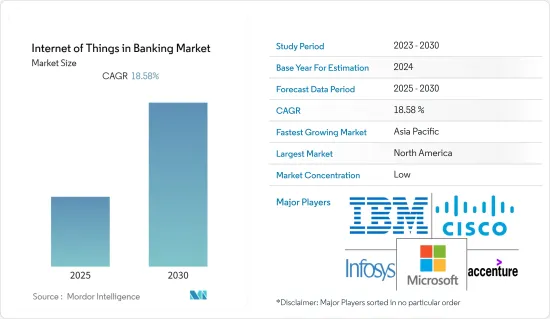Need help finding what you are looking for?
Contact Us
PUBLISHER: Mordor Intelligence | PRODUCT CODE: 1630182

PUBLISHER: Mordor Intelligence | PRODUCT CODE: 1630182
Internet of Things in Banking - Market Share Analysis, Industry Trends & Statistics, Growth Forecasts (2025 - 2030)
PUBLISHED:
PAGES: 120 Pages
DELIVERY TIME: 2-3 business days
SELECT AN OPTION
The Internet of Things in Banking Market is expected to register a CAGR of 18.58% during the forecast period.

Key Highlights
- One of the essential benefits of IoT in the banking industry is providing easy-to-access services to credit card and debit card customers. Banks can analyze the usage rate of ATM kiosks in specific areas and alter the installation of ATMs depending on usage volumes. Along with ATMs, banks can use IoT data to bring on-demand services closer to customers by providing kiosks and increasing the accessibility of service to customers. The customer data available through IoT can help banks identify their customers' business needs and value chains and gain customer insights. Customer information can help banks contribute to providing value-added services, financial assistance, and customized products to ensure a favorable situation for both parties.
- The market has a huge potential when it comes to retail banking. Banking via smart speakers provides customers with the convenience of issuing voice instructions rather than physically looking at a mobile device.
- IoT provides the BFSI industry with a variety of digitalization advantages, including a 360-degree client perspective, improved financial security, fraud detection, cutting-edge insurance tactics, and more. Innovations made possible by the Internet of Things assist banking and financial organizations in exceeding client expectations and providing superior customer service.
- Some banks have started using beacons to send customized offers to customers' smartphones as soon as they enter the branch. Some ATMs now have live-stream video support that allows customers to speak to tellers if they require additional assistance. Banks use IoT and other banking applications to resolve the conflict seen in traditional branch banking due to mobile banking. For instance, biometric sensors can be utilized to garner user data when they enter the bank and relay it to the primary system.
- To contain the spread of COVID-19, the majority of bank employees across the world are being asked to work from home. COVID-19 is also challenging the traditional banking habits of customers. The World Health Organization (WHO) has advised people to use contactless payment and avoid handling banknotes as much as possible. This is because COVID-19 may continue to live on a note for days, accelerating the spread of this disease. By implementing digitized and remote customer transactions, banks can ensure that everyday and exceptional processes are likely to be carried out with limited disruption. This represents an increasing adoption of IoT in banking in the future.
Internet of Things in Banking Market Trends
Security Application is Expected to Hold Significant Share
- Nowadays, customer expectations, technological capabilities, regulatory requirements, demographics, and economics create a crucial change. This demands that banking institutions move past these challenges and adopt a proactive approach to cybersecurity. The financial sector faced almost three times the cyber attacks compared to the other industries. Data breaches (internal through fraud and external through cybercriminals) lead to an exponential cost rise. Enforcing Multi-Factor Authentication (MFA), usually for physical access control, virtual private networks, and prevention of counterfeit by chip assembly integrators, are the critical trends in the cybersecurity applications market, which are expected to enhance the market.
- Personal Financial Management (PFM) is a 21st-century innovation. The PFM's guiding idea is simple: give consumers a clear image of their accounts, revenues, and expenses. Using a PFM system, the customer can see his accounts' transactions. Banks will be able to better serve their clients by using the data generated by IoT. To track the customer's usage, an IoT must provide alerts or signals to activate/deactivate particular items maintained by the bank.
North America to Account for a Significant Share
Internet of Things in Banking Industry Overview
Additional Benefits:
Product Code: 60371
TABLE OF CONTENTS
1 INTRODUCTION
- 1.1 Study Assumptions and Market Definition
- 1.2 Scope of the Study
2 RESEARCH METHODOLOGY
3 EXECUTIVE SUMMARY
4 MARKET INSIGHTS
- 4.1 Market Overview
- 4.2 Industry Attractiveness - Porter Five Forces
- 4.2.1 Bargaining Power of Suppliers
- 4.2.2 Bargaining Power of Buyers
5 MARKET DYNAMICS
6 MARKET SEGMENTATION
7 COMPETITIVE LANDSCAPE
8 INVESTMENT ANALYSIS AND FUTURE OF THE IOT MARKET IN BANKING SECTOR
Have a question?


SELECT AN OPTION
Have a question?


Questions? Please give us a call or visit the contact form.
